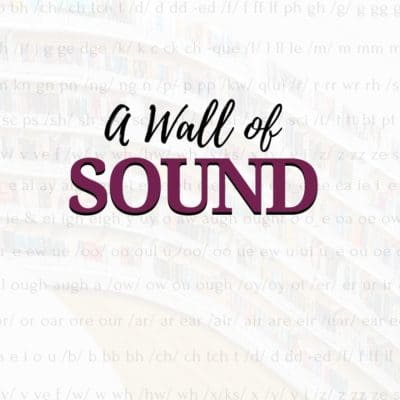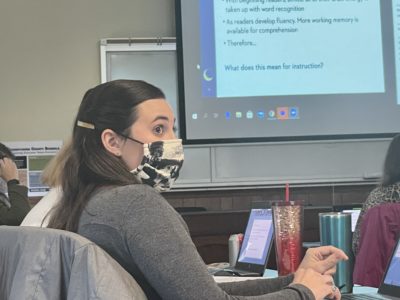
As a teacher or reading specialist for more than 20 years, Kim Geer has seen her share of state education laws and policies.
“It’s like every year something new comes along,” said Geer, a teacher at T.C. Henderson Elementary School of Science and Technology. “If we need to do something different, OK, that’s fine. But just help us to do it.”
Many elementary school teachers across the state feel the same way. With the General Assembly expected to consider reading legislation this session, we spoke with educators to find out what help they need.
“I think in creating any sort of legislation or policy, we have to make sure that we are bringing our teachers to the table, to have our teachers have a role in any sort of changes,” said Mariah Morris, the 2019 North Carolina Teacher of the Year and an advisor to the State Board of Education.
“We must design with them and not for them in this process. Because nobody [else] has to walk the walk of leading a classroom through the myriad of different needs in that room, alongside making any sort of pedagogical shift or cultural change,” she said.
Here are five takeaways from our conversations with educators.
Make training transformational, not burdensome
For starters, training should start when teachers are focused on knowledge-building — while they are in college, training to become teachers. We wrote more about that here.
It also means focusing on teacher leadership and empowerment. Morris has two ideas for doing this. First, bring back master’s pay to encourage teachers to get master’s degrees in reading. Second, reimagine teacher training.
Districts moving toward instruction based on the scientific research are doing a lot of training and professional development for teachers. Sometimes they pull teachers out of classrooms during the day, pay stipends to have them train on weekends, or send select teachers for training and then ask them to train others.
Morris said the state will get more buy-in if it pairs training with enrichment opportunities, like micro-credentials. Two of the restart schools in her district — Moore County Schools, where she is now innovation and special projects coordinator — have moved beyond training to create a three-tiered teacher leadership opportunity.
First, the North Carolina Center for the Advancement of Teaching provides some teachers and teacher assistants with virtual training in the science of reading. These teachers and teacher assistants receive a literacy badge.
After the training, the educators take a Canvas course the district built that reinforces the research and includes videos covering best practices. Finally, district coaches help these educators implement the learning in their classrooms.
Legislation requiring research-based instruction would get more teacher support if it includes these types of leadership opportunities, Morris said.
“Thinking about how we frame [professional development] so it’s not just sit and get,” she said. “It’s not, OK, there’s a reading law and we’re going to provide this webinar and then go do it. That’s not going to reach our teachers because, partly, it’s not respecting them.”
Help districts with curricula and materials
Joy Cantey is the director of literacy for Guilford County Schools. That district has taken steps for about four years to align instruction with the scientific research.
One of the main steps to achieving that, she says, is having a strong, evidence-based curriculum. Guilford is the third-largest district in the state and has resources at the central office to vet curricula. Not every district does, she said.
“Districts need support with selecting curriculum,” Cantey said. “All students across the state need a viable curriculum that they’re using. Teachers who don’t have a curriculum are left to just search the internet. The state needs to fund a curriculum. Districts can certainly have choice, and it doesn’t need to be the same curriculum in every single district, but there needs to be some funding for districts to adopt a comprehensive curriculum for literacy.”
She wants to see the state provide a list of approved curricula or create a rubric of essential components that a district’s curriculum must include.
The latter was a recommendation to the State Board of Education from the literacy task force it convened last year. Cantey was a member of that task force and said often that training teachers in the science of reading without providing them evidence-based curriculum creates disconnect and frustration.
Teachers also need funding and help selecting evidence-based materials for their classrooms.
Geer, for instance, is incorporating more decodable texts in her teaching. Her curriculum comes with some, but she needs more.
“I understand the premise of needing a decodable text,” she said. “So, (if) we’re going to do this, we need some good stuff.”
Provide instructional coaching and interventionists
While Cantey emphasizes the importance of curricula and programs, she points out that none is perfect.
“So we have to build capacity in educators, because the educators need to be smarter than the resource,” she said.
This means teachers, in addition to training and strong curriculum, need coaching.
Teachers say any law that changes instruction methods should include coaching supports.
“I can watch all the videos and stuff that you throw at me, and I do, but I would rather have a person, whether it’s outside or the instructional coach who lives here, come into the room and let me watch,” Geer said. “Model some lessons and show me.”
Morris said she wants legislators to recognize the difference between instructional coaches and interventionists. Instructional coaches, she said, work with teachers to build their capacity. Interventionists work with students.
“Our state needs to fund them both if we want to move the needle on reading instruction,” she said. “Unfortunately, we don’t have state funding for a lot of these positions, and a lot of districts are forced to only have coaches or interventionists at Title I schools. That’s a huge blind spot in our goal to move the needle on reading instruction.
“Because you can have the best crafted law or policy, but if we don’t have boots on the ground and personnel who are able to help make that shift, it’s not going to happen.”
Help with classroom size and personnel
The scientific research supports differentiating instruction for students depending on their decoding or oral language needs, but class sizes are an issue.
This year, state law mandates that K-3 class sizes average 18 students. But the law limiting class sizes did not include funding for teachers and teacher assistants.
In some classes, this means teachers are teaching first- and second-graders. Geer, for example, took on three first-graders in her second-grade classroom to keep the average numbers in other first-grade classrooms balanced.
The impact on fourth- and fifth-grade class sizes is stark, with 30 or more students in some classes.
“Nothing magical happens to a child who is struggling with reading when they cross the threshold to grade four,” Morris said. “And, unfortunately, those class sizes have ballooned.”
A related concern is lack of assistance in classrooms. Susan King is a first-grade teacher at Lakeshore Elementary School in Iredell-Statesville Schools. She said that when she began teaching, she had a teacher aide several times a week for an hour or more per day. Now, the assistance she gets is a fraction of that.
“I have taught over 20 years, and I have less help now than I have ever had,” King said. “They are asking us to do all of this intensive reading instruction, but it works best in small groups. If you work with 6-year-olds, you cannot leave them unattended while you go work with other groups. They have to be managed. And so it’s great [to see] the need for teaching reading through the science of reading, but if we have 20 kids in our class and no assistant, we can’t do it with our hands tied behind our backs.”
Provide testing and assessments that align with expectations
Teachers worry about disharmony between how leaders want them to teach and how they assess teacher performance. They also worry about whether the assessments they use will test on what the state expects them to teach.
The testing inconsistencies begin before teachers enter the classroom. For licensure, teachers in the state have to pass a North Carolina Foundations of Reading exam. This exam tests teacher candidates on cueing students to predict words, a strategy that isn’t supported by the scientific research.
At Lenoir-Rhyne University, the college of education builds its elementary education literacy program around the scientific research. Monica Campbell, the coordinator of its elementary education program, says she still has to cover cueing for the pre-licensure exam, even though she tells her teacher candidates to forget the lesson after the exam.
“It shouldn’t be on that exam,” Campbell said. “If we are on board with the science, that can’t be on there.”
Campbell said she is part of a task force re-examining pre-licensure exams and hopes this will change.
The issue in the classroom has been more complicated. Assessments such as mCLASS and Istation were in the news a lot the last couple years, but much of the discussion was about how assessments were procured, not how well they perform.
In the classroom, some teachers say they aren’t happy with either assessment.
Carrie Norris, curriculum director in Transylvania County Schools, recalled that many teachers in her district were disappointed switching to Istation because they liked mCLASS. But training on the science of reading has changed that attitude some.
“I know we hated for mCLASS to go away,” Norris said to a group of instructional coaches, “but what did we care about the most at the end of the assessment?”
Almost in unison, the coaches said, “That level.”
They were referring to a level that mCLASS would assign a student after the assessment, at which point that student’s teacher would recommend books at that level for the student to read. These are called leveled readers.
Reading class in most elementary schools include whole-group instruction followed by small-group blocks. During small groups, there is disparity among the types of books kids are reading. Two common types are leveled readers and decodable texts.
Leveled readers are prevalent in reading classrooms where whole-language approaches are used, and they are included in balanced literacy curricula. In Transylvania County Schools, many teachers are now replacing these with decodable and knowledge-rich texts.
Haley Dawson, a first-grade teacher in TCS, appreciates that Istation breaks student proficiency across five fundamentals — phonics, phonological awareness, fluency, vocabulary, and comprehension — but she and other teachers say they still worry about Istation.
They worry about accuracy. For instance, they see students who are guessing words perform better than students who are sounding out phonemes, just because the guessers are finishing quicker. They also worry about screen time.
But their biggest concern: Some of what is being assessed isn’t what they believe they are asked to teach. There should be consistency there, they say. They add that state-mandated testing should also reflect what happens in a classroom with science-aligned instruction.
“To get ultimate, ultimate, ultimate buy-in — because there are a lot of teachers who teach to the test — if the test matches what the science says, then if you are someone who teaches to the test, you’ll be teaching the science,” Dawson said.
Editor’s note: Mariah Morris is on the Board of Directors for EducationNC.



